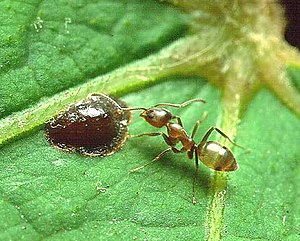Line theme
| Line theme | ||||||||||
|---|---|---|---|---|---|---|---|---|---|---|

Argentine ant ( Linepithema humile ) |
||||||||||
| Systematics | ||||||||||
|
||||||||||
| Scientific name | ||||||||||
| Line theme | ||||||||||
| Mayr , 1866 |
Linepithema is a genus of ants . They occur with 19 species in South and Central America as well as in the Caribbean . Only one species, the Argentine ant ( Linepithema humile ), was spread by humans and is now also native to Europe , North America , South Africa , Australia , the Azores , the Canaries and Hawaii . Another two species of this genus are known from fossil finds.
features
The Linepithema species have five to eight larger and five to 13 other small teeth on the insides of their mandibles . The first tooth at the tip is significantly larger than the others. Another feature of this genus is the frontal plate ( clypeus ), the front edge of which has a broad, slight curvature. They look very similar to some types of Iridomyrmex , but can be easily distinguished from them by the larger number of teeth on the mandibles, a tear-shaped head, the relatively low position of the compound eyes and the shape of the faceplate.
Occurrence
The ants occur from northern Mexico south to northern Argentina . They are also found in the Caribbean but are absent from Cuba , although they are found in large numbers in Hispaniola and Puerto Rico . In the Amazon basin , they are less common. The largest distribution of species and individuals is found around 20 to 30 ° south latitude. They occur from sea level up to an altitude of 4,000 meters. They live in forests, on grasslands and in the mountains.
Way of life
The nocturnal and diurnal animals feed both predatory and scavenging, as well as honeydew and nectar. With the help of their pheromone traces, they can quickly lead a very large number of workers to feed sources. Their nests are built superficially in soil, between dry leaves, dead wood, or under stones. Two species, L. iniquum and L. leucomelas build their nests on trees. The colonies are usually populous and have more than 1,000 individuals. The Argentine ant is a dreaded pest close to humans and, once inside a house, is extremely difficult to control. It is not uncommon for them to form colonies with several nests that are connected to one another by ant trails. By displacing native species of ants, they also affect the ecosystem. Carney, Byerley and Holway report that the spread of the relatively large seeds of the myrmekochor poppy family Dendromecon rigida near the coast of San Diego is severely impaired because the Argentine ant does not spread the seeds, but the native ant species Pogonomyrmex subnitidus , which has so far spread the seeds had taken over, pushed back. Christian reports a similar story from South Africa: the plant communities of the bushland are being changed because the large seeds of the Argentine ant are not spread.
credentials
- ↑ a b Alexander L. Wild: Taxonomic Revision of the Ant Genus Linepithema (Hymenoptera: Formicidae) . In: UC Publications in Entomology , Vol 126, January 12, 2007; [1]
- ↑ SE Carney, MB Byerley and DA Holway, DA: Invasive argentine ants ( Linepithema humile ) do not replace native ants as seed dispersers of Dendromecon rigida (Papaveraceae) in California, USA. Oecologia Volume 135, 2003, pages 577-582.
- ↑ Caroline E. Christian: Consequences of a biological invasion reveal the importance of mutualism for plant communities. Nature Volume 413, 2001, pp. 635-639.
Web links
- Line theme. In: AntWiki. Retrieved July 20, 2013 .